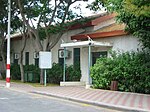Rosh HaAyin springs
Springs of Israel

Rosh HaAyin springs, also called the Yarkon springs or the Ra's al-'Ayn springs, are springs located at the foot of Tel Afek, in the Yarkon National Park which was established in the region that surrounds the springs. These springs are one of the water resources of the Yarkon River. Until the 20th century, the water of the Rosh HaAyin springs flew into the Yarkon River, but nowadays most of the water of the Rosh HaAyin springs is used in various irrigation projects and does not reach the Yarkon River.
Excerpt from the Wikipedia article Rosh HaAyin springs (License: CC BY-SA 3.0, Authors, Images).Rosh HaAyin springs
Rosh HaAyin, Drom HaSharon Regional Council
Geographical coordinates (GPS) Address Nearby Places Show on map
Geographical coordinates (GPS)
| Latitude | Longitude |
|---|---|
| N 32.104425 ° | E 34.926780555556 ° |
Address
ראש העין
Rosh HaAyin
4851136 Drom HaSharon Regional Council
Center District, Israel
Open on Google Maps










